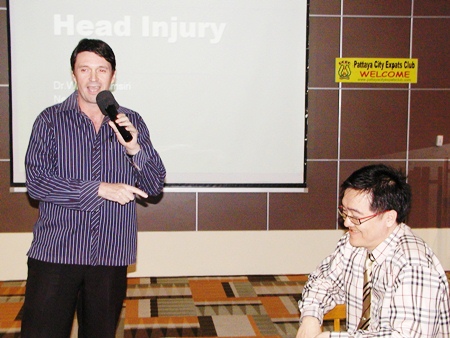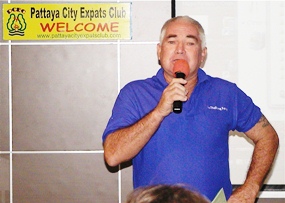PCEC given a look at head injury detection and treatment
On November 21, master of ceremonies Les Edmonds welcomed everyone to the regular Sunday meeting of the Pattaya City Expats Club at the Tavern by the Sea. After the usual opening announcements, he called on fellow member Gavin Waddell, international marketing executive for Phyathai Sriracha Hospital, to introduce the guest speaker Dr. Wirote Jiamsiri, M.D., a neurosurgeon from the hospital to talk about head injuries. Dr. Wirote is a Fellow of the Board of Neurosurgery in Thailand with a lot of experience in treating head trauma.
Dr. Wirote said the definition of a head injury is an outside force hitting the head that can injure the scalp, skull, or brain; they can be open or closed. The most common causes of head injury are motor vehicle accidents, falls, and physical assault.
 PCEC member Gavin Waddell, also international marketing executive for Phyathai Sriracha Hospital, introduces the guest speaker Dr. Wirote Jiamsiri, M.D., a neurosurgeon from the hospital, to talk about head injuries.
PCEC member Gavin Waddell, also international marketing executive for Phyathai Sriracha Hospital, introduces the guest speaker Dr. Wirote Jiamsiri, M.D., a neurosurgeon from the hospital, to talk about head injuries.
Head injuries have various symptoms and they may not appear immediately or even after a day or two. Common symptoms of brain injury can be coma, confusion, drowsiness, personality change, headache, convulsions, nausea, change in pupils, and/or fluid coming from ears or nose. In determining the seriousness of a head injury, Dr. Wirote said that doctors use the Glasgow Coma Scale. This scale is based on a patient’s ability to open his or her eyes, give answers to questions, and respond to physical stimuli, such as a doctor’s touch. A person can score anywhere from three to fifteen points on this scale. A score of 13 to 15 indicates mild damage, a score of 9 to 12 indicates moderate damage, and a score of 3 to 8 indicates the presence of serious brain damage.
Consequently, when a moderate or serious head injury is suspected, the patient may be kept in the hospital for observation for a few days. Diagnostic tests can also be performed, which can include computed tomography (CT) scan and magnetic resonance imaging (MRI) among others.
 The Ozzy skipper of the new ferry service from Pattaya to Hua Hin introduces the service to PCEC members.
The Ozzy skipper of the new ferry service from Pattaya to Hua Hin introduces the service to PCEC members.
The CT scan and MRI provide visual images of the brain. Dr. Wirote displayed several pictures of the results of these tests and explained which pictures revealed subdural or epidural hematomas. He also noted that X-rays can be used to identify skull fractures.
The next step in treatment depends on the nature of the injury. In the case of a penetrating wound, surgery may be necessary. In a closed head injury, surgery may still be needed to drain blood from the brain or to remove a clot. Surgery also may be needed to repair severe skull fractures. Dr. Wirote showed several pictures of the surgical procedures for brain injury. In conclusion, Dr. Wirote said that prevention should be through the use of safety equipment, such as helmets or seatbelts.
After Dr. Wirote answered several questions from the audience, Les called on Richard Silverberg, the club’s Internet guru to give everyone his latest “find.” Richard said the website for HSBC Bank has a section with a report on a survey of expats around the world. He noted that the place picked as the overall best was Thailand. If you want to see the report, go to http://tinyurl.com/HSBCexpat.
Les then called upon a representative of Thailiving; the company that has a ferry service between Pattaya and Hua Hin. He informed everyone that this service has just started and is currently available 3 days a week. They use a catamaran that is equipped to meet Australian safety standards. The ferry travels at 20 to 22 knots and it takes about 3 hours to travel the 59.2 miles between Pattaya and Hua Hin. The Catamaran will accommodate 70 passengers and a crew of 5 and has a small refreshment bar aboard and bus type seats that can recline. The representative did mention that the waters between the two cities can be very rough at times; when it is severe, the crossing will be canceled. For more information about the service, you can visit their website at http://www.thailivingferry.com/
In concluding the meeting, Les updated everyone on upcoming events in and around Pattaya and called on Roger Fox to conduct the always informative and sometimes humorous Open Forum, where questions about living in Thailand and Pattaya in particular are asked and answered.




